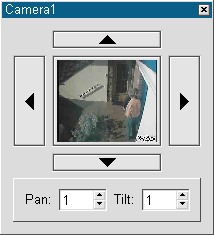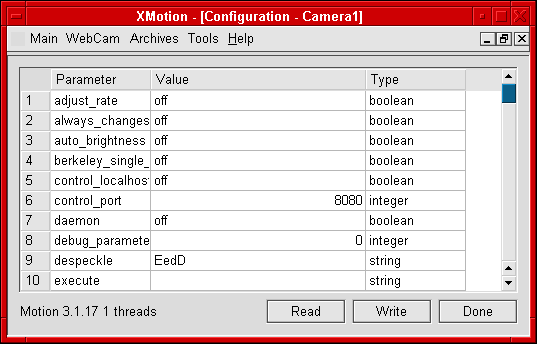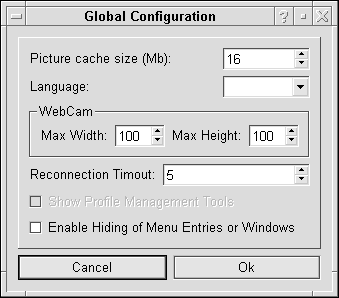


3.1 Profile Management
Every parameter concerning the
Motion
application or the captured pictures
are stored into a profile. the profile contains the list of parameters for
each camera which permits to setup the archive picture viewer
(see chap. 3.1)
, the WebCam
(see chap. 3.1)
, the timing
configuration
(see chap. 3.1)
, the list of function available
(see chap. 3.1)
and the remote control of
Motion
(see chap. 3.1)
. A profile should be created pro camera and
needs to have an unique Camera Name as identifier.
Topologies
The features provided by
XMotion
is depending from the
Motion
configuration
(activation of XML-RPC or the WebCam interface)
and the Linux configuration on which
Motion
is installed.
Figure 3.1: Archive of Picture Viewer configuration Example
To provide the "Archive Viewer",
XMotion
needs a possibility to read
the directory on which the pictures are stored. This can be on the local file
system or via FTP (see figure 3.1).
XMotion
does not handle every file name layout: only the "oldlayout"
and the "newlayout"1 (with directories) are supported
(see chap. 7)
.
Figure 3.2: WebCam configuration Example
To provide the "WebCam",
Motion
needs to be configured with
the WebCam interface activated. The control of the Tilt/Pan of the camera
can only be used if the XML-RPC or HTTP-API is configured (see figure
3.2). The XML-RPC or HTTP-API is recommended for
this interface for retrieving the first picture of the camera (
XMotion
modify
some settings to force
Motion
to send the first picture).
Figure 3.3: Remote Configuration configuration Example
To provide the "Motion Remote Configuration",
Motion
needs to be
configured with the XML-RPC or HTTP-API support (see figure
3.3).
Figure 3.4:
Motion
Tuning configuration Example
To provide the "Tuning Interface of Motion",
Motion
needs to be configured with
the WebCam interface activated and with the XML-RPC or HTTP-API support (see figure
3.4).
Archive Configuration
Figure 3.5: Profile - Archive Configuration
The "Archive Location" part contains the communication parameters
necessary to view the archive of pictures which where captured by
Motion
23.
For the FTP access it is possible to use an authentification mechanism
(login+password). In this case, the login need to be entered into the profile.
The password can also be saved into the profile or, if not saved, a prompt will
ask for it on the connection.
WARNING: The password is saved in clear text into the profile.
Remote Control of
Motion
Figure 3.6: Profile - Remote Control
The "Motion XML-RPC" part, is used for the remote configurating of
Motion
(see chap. 3.4)
. The Motion-XML-RPC protocol need to be
enabled.
WebCam Configuration
Figure 3.7: Profile - WebCam Configuration
The "WebCam" part, is used for the configuration of the WebCam feature
of
Motion
(see chap. 3.3)
. The Motion-XML-RPC protocol and the WebCam
Http server need to be enabled. The check box Tilt/Pan Camera permits
to enable the interactive modification of the tilt and the pan4. The check box Pictures when a movement is
detected permits to upload only a picture when
Motion
detect a movement.
Additionally,
XMotion
can play a WAV audio file (check box Play sound
on new Picture)5
or let the background blinking (check box Blink on new Picture) when a
new picture is uploaded.
Timing Configuration
Figure 3.8: Profile - Timing Configuration
The "Timing Synchronization" part, is used for configurating the archive picture viewer.
-
Synchronization Time
-
this parameter is use for displaying the pictures with the
same timing as their were captures. This happened only for
pictures which are captures in time frame of
"Synchronization Time" seconds.
(see chap. 3.2.2)
- Skip Time
-
this parameter is use for the fast forward
(
 ) and rewind button
(
) and rewind button
( ). Clicking on this button will
force
XMotion
to find the next (resp. previous) picture which are
captured in a time frame greater than "Skip Time" seconds.
(see chap. 3.2.3)
). Clicking on this button will
force
XMotion
to find the next (resp. previous) picture which are
captured in a time frame greater than "Skip Time" seconds.
(see chap. 3.2.3)
Windows Configuration
Figure 3.9: Profile - Windows Configuration
-
Remote Configuration:
- This option permits to hide the "
Motion
Remote
Configuration Sheet" menu entry
(see chap. 3.4)
.
- Tuning of Motion:
- This option permits to hide the
"
Motion
Tuning" menu entry
(see chap. 3.5)
.
- Archive:
- This option permits to hide the "Archive"
menu entry
(see chap. 3.2)
.
- WebCam:
- This option permits to hide the "WebCam" menu entry
(see chap. 3.3)
.
WARNING:
XMotion
hides menu entries only if this function is globally enabled
(see chap. 3.6)
.
Miscellaneous Configuration
Figure 3.10: Profile - Miscellaneous Configuration
The "Working Directory" is a directory which is used for saving the
viewed pictures
(see chap. 3.2.4)
. If this directory is not
defined, saving pictures on the local computer is disabled.
Click on "Main->New Profile" to create a new profile.
Enter first a "Camera Name". This name is used as identifier of the profile.
To remove a profile click on "Main->Remove Profile->Selected profile".
Modifying a profile works exactly as creating a new one. As long as the "Camera Name" is not modify, the parameter of the selected profile is modify. If the "Camera Name" is modify then a new profile is created.
3.2 Picture Archive Viewing
XMotion
is able to display the pictures captured in a "media player" look and feel.
This function require:
-
Access to the directory, which contains the list of pictures, via FTP
- or Mounting the directory, which contains the list of pictures, locally.
All buttons which permits to interact with the archive viewer are located in tool bars. Use the menu entry "Tools" to display it.
3.2.1 Connection
The connexion parameters are specified into the profile.
Is a password is needed for the communication, a input window will be popped up
on each creation of a new instance of the archive viewer.
3.2.2 Playing a picture sequence
If pause button ( ) is off,
XMotion
starts to play a picture sequence.
It is possible to play the sequence forwards or backwards.
) is off,
XMotion
starts to play a picture sequence.
It is possible to play the sequence forwards or backwards.
If "Time Sync" is checked, the sequence is playing respecting the capture timing. If unchecked,
XMotion
plays the sequence pictures after pictures as fast as possible.
Pause mode
If pause button ( ) is on, the pause mode is selected.
) is on, the pause mode is selected.
The current sequence is freezed and all navigation operation (fast forward, jump to a date,...) are showing only one picture.
Time-sync mode
The synchronization is activated if the check box "Sync-time" is checked.
In this mode,
XMotion
tries to display the video sequences with the same
timing as for the capture. This means: if a picture is captured every
seconds,
XMotion
will display every second a picture.
It is possible to force
XMotion
to display the current picture by
clicking on  .
.
In the profile (for configurating
(see chap. 3.1)
) it is possible to
define the maximal time between 2 picture under which the synchronization
is activated.
Example:
|
Date |
Pictures Captured |
|
22-01-2000 12:00 |
pic1 |
|
22-01-2000 12:02 |
pic2 |
|
22-01-2000 12:03 |
pic3,pic4,pic5 |
|
22-01-2000 12:15 |
pic6 |
|
22-01-2000 12:18 |
pic7 |
The maximal synchronization time is set to 10s.
XMotion
will play back the sequence as follow:
|
|
display pic1 |
| wait 2s |
display pic2 |
| wait 1s |
display pic3 |
| wait 0.33s |
display pic4 |
| wait 0.33s |
display pic5 |
| do not wait |
display pic6 |
| wait 3s |
display pic7 |
Synchronization-less mode
In this mode, playing a sequence of pictures will simply display
one picture after an other, as fast as possible.
3.2.3 Search functions
Fast forward/rewind
The fast forward ( ) and the rewind button(
) and the rewind button( ) can be used to jump to the previous/next sequence.
A sequence of pictures is delimited between a blank (no pictures captured)
of Skip Time seconds.
(see chap. 3.1)
) can be used to jump to the previous/next sequence.
A sequence of pictures is delimited between a blank (no pictures captured)
of Skip Time seconds.
(see chap. 3.1)
Example:
|
Date |
Pictures Captured |
|
22-01-2000 12:00 |
pic1 |
|
22-01-2000 12:02 |
pic2 |
|
22-01-2000 12:03 |
pic3,pic4,pic5 |
|
22-01-2000 12:15 |
pic6 |
|
22-01-2000 12:18 |
pic7 |
The skip time is set to 10s.
If the current picture displayed is pic1,
XMotion
will jump to pic6 if clicking on  , because the time between pic5 and pic6 is greater than 10s.
, because the time between pic5 and pic6 is greater than 10s.
Selecting a date
To view the pictures from captured at a specific date process as follow:
-
Change the date in the input field.
- Click on the button "Date".
Checking for new pictures
The check for new pictures button6
( ) permits to check if new
pictures are captured and set the current position to the last captured
picture.
) permits to check if new
pictures are captured and set the current position to the last captured
picture.
3.2.4 Recording viewed pictures
It is possible to record the pictures viewed when a "Working Directory" is defined.
(see chap. 3.1)
If no "Working Directory" is defined, the save button is hide.
When the save button ( ) is "on" every pictures displayed will be recorded into the working directory. The format of the file is: <profileName>-<date>-<time>.jpg.
) is "on" every pictures displayed will be recorded into the working directory. The format of the file is: <profileName>-<date>-<time>.jpg.
3.2.5 Preferred Picture Type
The "Miscellaneous" tool bar permits to select the preferred view of the picture sequence.
This option permits to switch between the "camera view" (normal output from the camera)
and the "motion view" (motion output which permits to see where the movement was detected).
WARNING: If the "motion" picture is not generated, this setting does not have any impact.
3.2.6 Cache handling
XMotion
uses 2 kind of caches:
-
Picture Cache:
- this cache is a global cache which store a copy of the JPEG files read.
This permits to reduce the necessary bandwidth when replaying a sequence.
The maximum size can be configured in the global options.
- Directory Cache:
- this cache is created per profile,
and contains a copy of the directory structure. This cache is build
"when reading some items are needed" to avoid to read the complete remote
directory7.
|
Icon |
Shortcut |
 |
Space |
 |
Ctrl-S |
 |
Arrow-Left |
 |
Ctrl-Arrow-Left |
 |
Arrow-Right |
 |
Ctrl-Arrow-Right |
 |
Ctrl-Space |
 |
Ctrl-? |
3.3
Motion
WebCam
XMotion
is able to display in the tool bar the actual picture of the camera.
This function require that
Motion
has a configure WebCam Http server activated.
Clicking on the picture will open the corresponding archive viewer and show
the last captured picture.
XMotion
can play a sound8 or blink on incoming picture. This is
useful if
Motion
is configured to upload only pictured when a movement
is detected. If activated, it is possible to modify the tilt and pan of
the camera.
The general configuration
(see chap. 3.6)
permits to define the maximal size of
the picture displayed.
WARNING: The Tilt/Pan support is an untested feature.
3.4
Motion
Remote Configuration
The configuration of
Motion
can be interactively modified if
Motion
have the XML-RPC activated.
The
XMotion
profile must contain the server name and the XML-RPC port number.
It is possible to modify directly the parameters from the table. Each modification is committed immediately.
"Read" will re-read all parameters. "Write" will write the changes to the initialization file.
3.5 Tuning
Motion
The "Tuning Window" permits to modify some tuning parameters of
Motion
interactively. Each modification of the parameters are committed
immediately to
Motion
. The "Write" button permits to write the
configuration into the configuration file of
Motion
. The "Restore"
button restore the settings made until the "Write" button was clicked
or until the "Tuning Window" was opened.
3.6 Options
The option dialog contains options which are related to the whole application.
-
Language:
- Application language. This option need a restart of the application.
- Picture Cache Size:
- Size in megabytes of the picture cache.
- Reconnect Timeout:
- When a connection is closed,
XMotion
perform a reconnection after "Reconnect Timout" seconds.
- WebCam Width/Height:
- Maximal size of the WebCam pictures.
- Show Profile Management Tools:
- This option permits to hide all menu entries which permits to create, modify or delete a profile.
- Enable Hiding of Menu Entries or Windows:
- Global enable for all hiding function.
- 1
- The newlayout is the preferred
format.
- 2
- This archive can use the old or the new name
formation
- 3
- It is generally better to use the new name format due to
the directory structure used. This permits to ready only partially the list of
captured pictures.
- 4
- If
supported by
Motion
- 5
- Only available is Qt is compiled with sound support
- 6
- This manual operation is needed
due to the cache management.
(see chap. 3.2.6)
- 7
- This works only if
Motion
is configured to support the new file format.
For the old format, the complete directory tree of the archive need to be read,
this can cause some performance issues.see motionsettingnew file format
- 8
- This require
Qt configured with sound support.
This project is sponsored by CoverageMeter - Software Test Performance Measurement











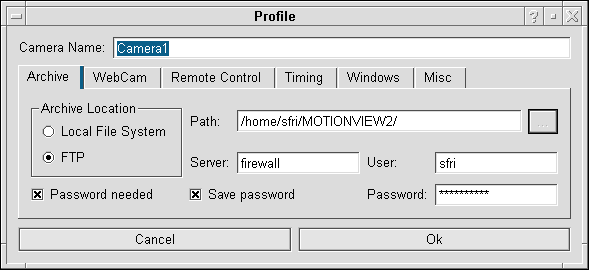
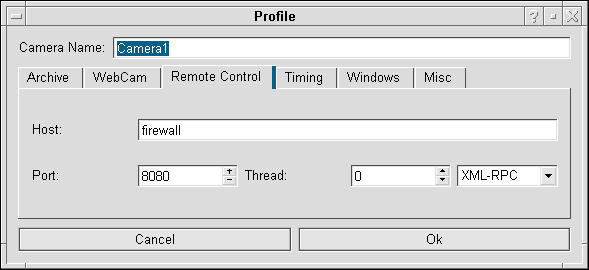
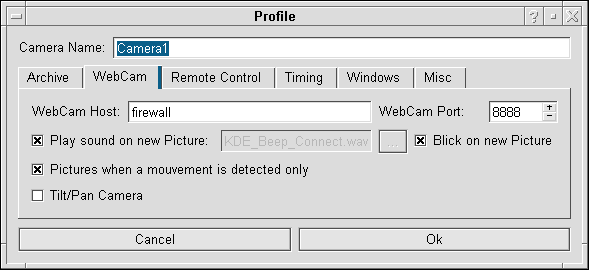
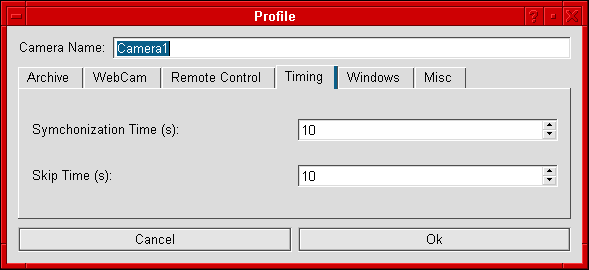
 ) and rewind button
(
) and rewind button
( ). Clicking on this button will
force
XMotion
to find the next (resp. previous) picture which are
captured in a time frame greater than "Skip Time" seconds.
(see chap. 3.2.3)
). Clicking on this button will
force
XMotion
to find the next (resp. previous) picture which are
captured in a time frame greater than "Skip Time" seconds.
(see chap. 3.2.3)
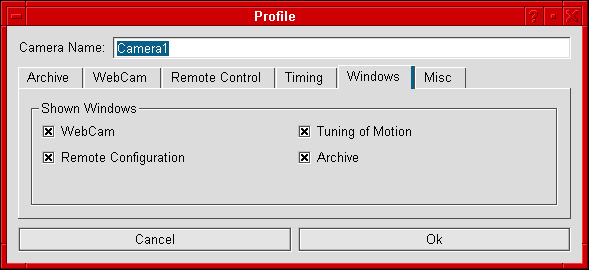
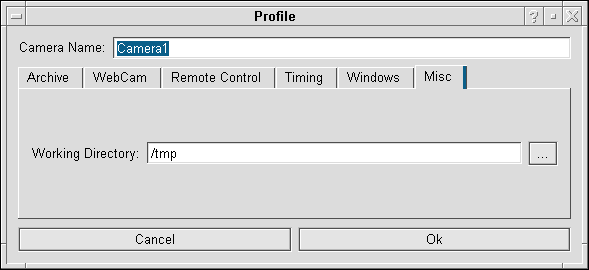
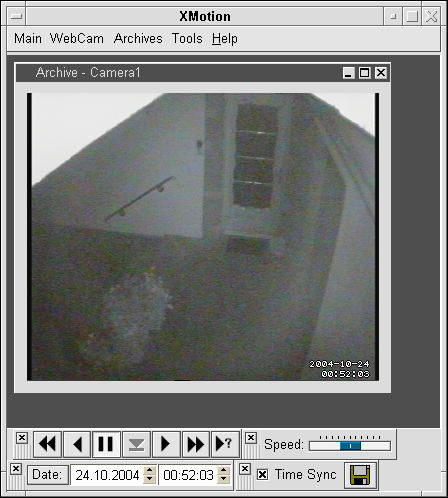
 ) is off,
XMotion
starts to play a picture sequence.
It is possible to play the sequence forwards or backwards.
) is off,
XMotion
starts to play a picture sequence.
It is possible to play the sequence forwards or backwards.
 ) is on, the pause mode is selected.
) is on, the pause mode is selected. .
. ) and the rewind button(
) and the rewind button( ) can be used to jump to the previous/next sequence.
A sequence of pictures is delimited between a blank (no pictures captured)
of Skip Time seconds.
(see chap. 3.1)
) can be used to jump to the previous/next sequence.
A sequence of pictures is delimited between a blank (no pictures captured)
of Skip Time seconds.
(see chap. 3.1)
 , because the time between pic5 and pic6 is greater than 10s.
, because the time between pic5 and pic6 is greater than 10s.
 ) permits to check if new
pictures are captured and set the current position to the last captured
picture.
) permits to check if new
pictures are captured and set the current position to the last captured
picture.
 ) is "on" every pictures displayed will be recorded into the working directory. The format of the file is: <profileName>-<date>-<time>.jpg.
) is "on" every pictures displayed will be recorded into the working directory. The format of the file is: <profileName>-<date>-<time>.jpg.








